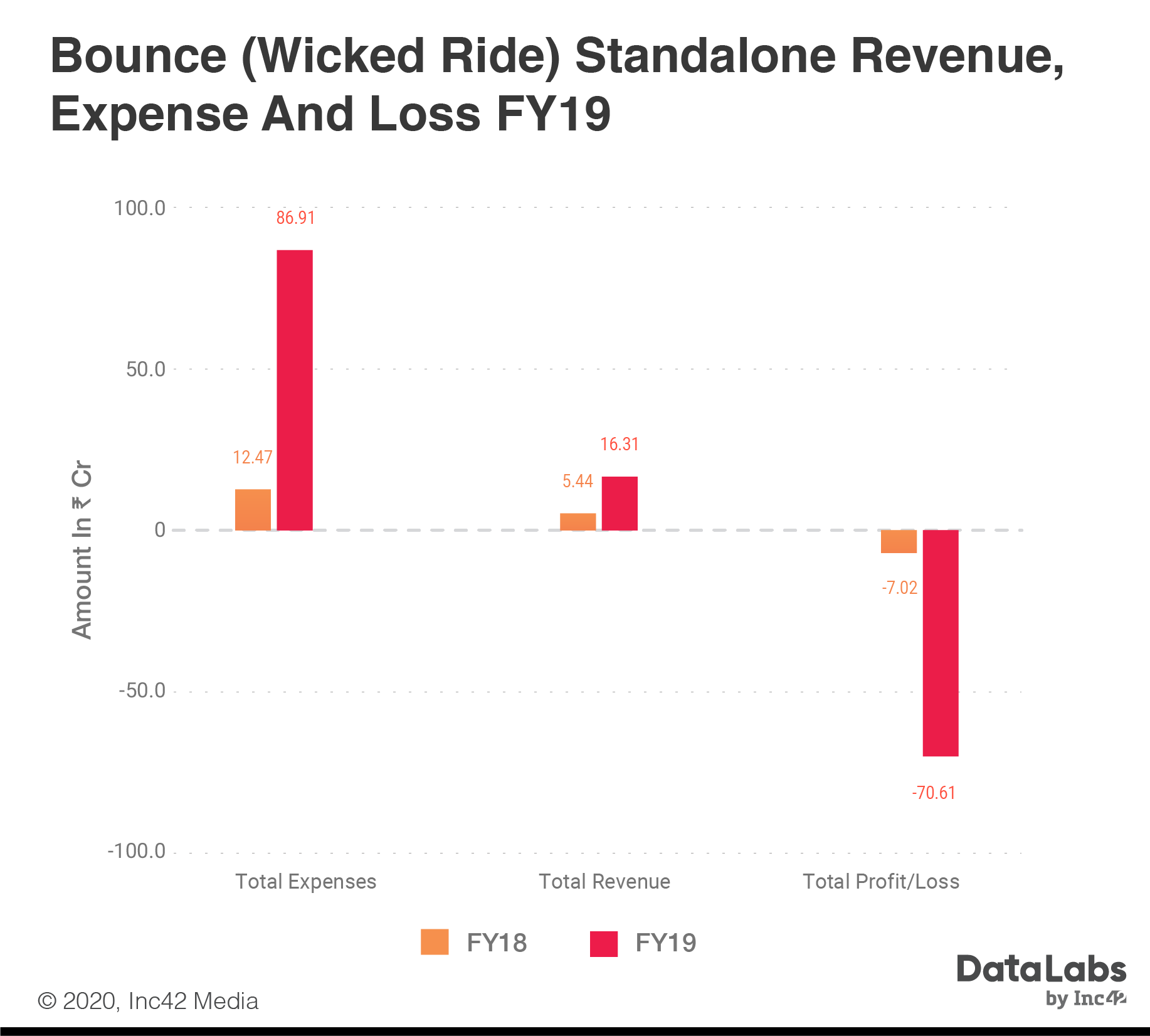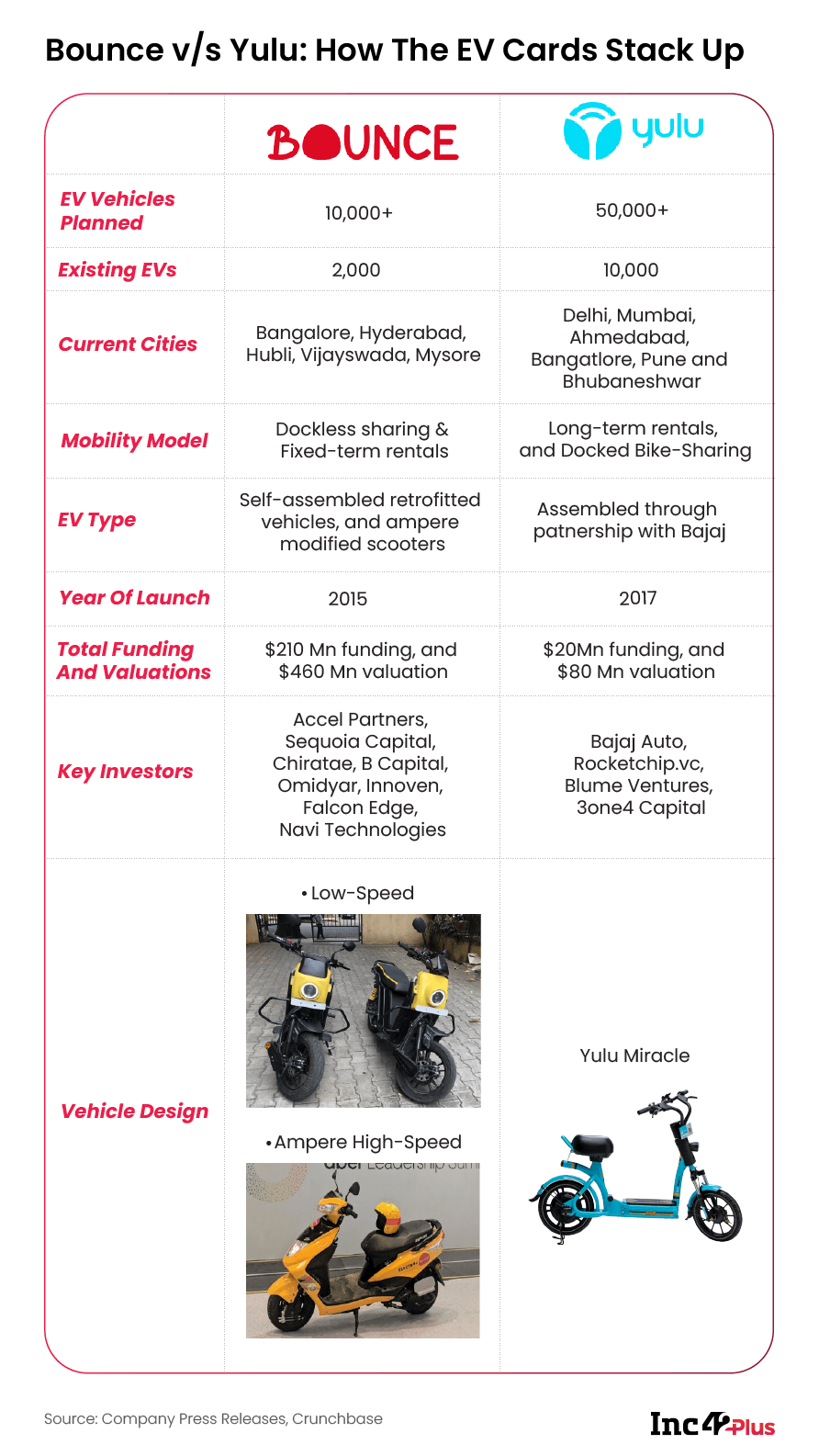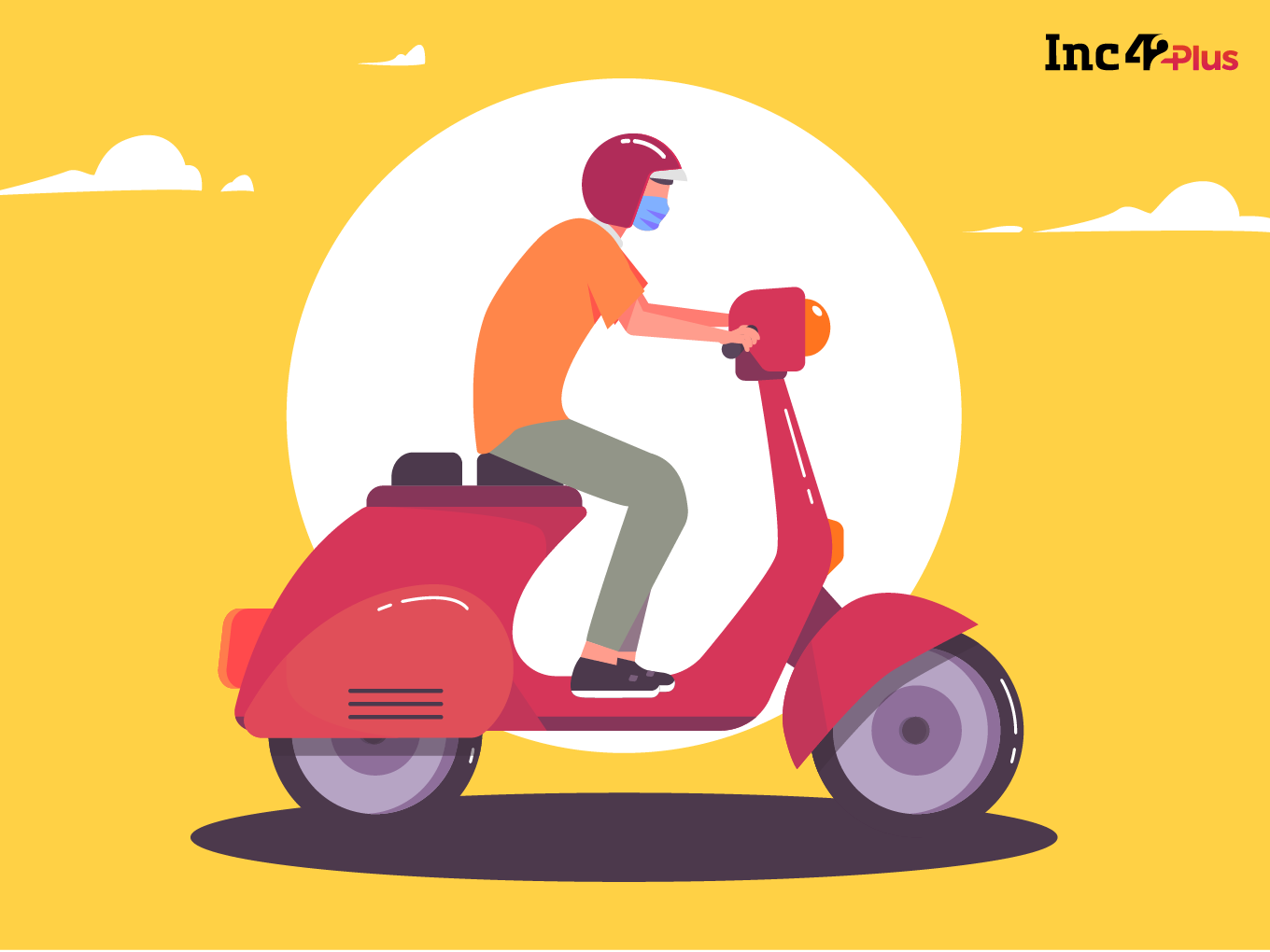SUMMARY
Bounce had to cope with near-zero demand for its shared bikes after the pandemic struck, but it is now eyeing EV play
The startup’s new-found love for EVs has led it to work on certification and go down the difficult path of self-assembling its vehicles
After liquidating most of its assets on the ground, Bounce is knee-deep into EVs; will investors buy its pitch?
In a world under the cloud of a deadly pandemic, strategic pivots are needed to survive in the new normal. As for the ride-sharing companies, one of the worst-hit segments still struggling to recover from mandated lockdowns and social distancing norms, it was mostly about layoffs and pay cuts to reduce their burn rates and keep operations afloat. Others, like Bounce (registered under Wicked Ride Adventure Services), a two-wheeler-sharing startup from Bengaluru, have decided to juggle a few options and pivot accordingly to nurture a never-say-die approach.
Bounce is no stranger to pivots if we care to look at its journey and road map. The concept had its roots in a teenager’s dream of owning a luxury bike, which he could not afford. Understandably, high-end bikes are never pocket-friendly until one opts for rental, rather than ownership, and undertakes short trips within the city limits. So, in April 2014, Vivekananda Hallekere, the chief executive officer of Bounce, and two other young cofounders – Anil G and Varun Agni – launched Wicked Ride, an exotic bike rental company. It offered premium bikes across storied brands such as Harley Davidson, Royal Enfield, Triumph-Bonneville, Kawasaki Ninja, Indian Scout and Ducati. By the time it completed a year or so, Wicked Ride had already serviced 2,500 rides and even mopped up a seed round of $787K (INR 5 Cr) in July 2015 from an undisclosed angel investor.
At the time, Hallekere told Inc42 that the luxury rental market could be pegged at around INR 3,630 Cr, mainly serving a population in the age group of 23-39, with a disposable income of INR 4.5 Lakh per annum.
The first pivot came in 2016 as Hallekere and his team started a new initiative called Metrobikes. As the name suggests, it was a scooter rental service for first- and last-mile connectivity with most of the metro stations across the city. In February 2018, Metrobikes also signed a strategic partnership with Bengaluru Metro Rail Corporation (BMRCL) to park 65-100 bikes at several metro stations. Commuters could either book their vehicles on the spot or use an app to discover bikes around those stations. Also, Metrobikes had to shell out a whopping $424K (INR 2.75 Cr) per year for renting dedicated parking areas.
The luxury bike rental service was not discontinued, of course; In fact, it is still running. But by 2016, the Bounce CEO was less passionate about luxury vehicles and more focussed on ensuring that mobility remains a ‘fundamental right’. It is a vision he has been selling to customers and investors for a while now.
But one cannot undermine the critical reason behind any pivot – an increase in customer outreach and revenue. And this was apparent from the company’s financials. During its initial years of operations (2014-2016) as a luxury bike rental service, the parent company only recorded small revenue growth. But the shift towards a mass model since 2018 had seen better growth. For instance, the parent firm posted operating revenue of Rs 1.4 Cr in FY2015-16, followed by Rs 4.25 Cr in FY2016-17 and Rs 5 Cr in FY2017-18. But by FY2018-19, its revenues tripled, thanks to the next two pivots.

By August 2018, Metrobikes quietly adopted a dockless bike-sharing model, allowing its users to pick up their vehicles from anywhere within the city limits and drop them likewise. The dockless model was quite a novelty in India at the time, but the co-founders were inspired by similar developments in the European and the Chinese markets. Furthermore, Bounce introduced a keyless scooter-unlocking tech that worked using Bluetooth. This was required as most of the riders used their smartphones to locate nearby vehicles (fitted with GPS for easy tracking).
There were other benefits of the pivot, including significant growth in the number of rides even though expenses shot up as the startup had to deploy more scooters to meet the growing demand. Bounce’s operating expenses for its bikes alone shot up to INR 11.6 Cr in FY19 as against INR 2.12 Cr in FY18. Plus, the cost of helmets increased to INR 1.7 Cr in FY19 from INR 6.89 Lakh in FY18. The company also saw a 5.68x increase in its advertising and promotional expenses.
Meanwhile, venture capitalists came calling to give the company a further boost and see the shared mobility model play out in India. Nearly seven months after tying up with the BMRCL, the startup raised $12.2 Mn Series A, led by Sequoia Capital, and Accel Partners.
By January 2020, Bounce was witnessing incremental growth despite a significant rise in operating expenses. It was already in 12 cities and towns, the majority being Tier 2 and Tier 3 locations in Karnataka, and had deployed 28-30K petrol scooters across these places. In Bengaluru alone, the company was able to scale to 90-100K rides per day and also had around 1,000 electric vehicles (EVs) in place for ride-sharing.
The year 2020 was off to a flying start, thanks to a $105 Mn (INR 746.33 Cr) Series D round led by Accel Partners and B Capital Group, valuing the startup at around $450 Mn. It was a 2.2X rise from the $200 Mn valuation Bounce had witnessed during the Series C round in June 2019.
The Pandemic And After
Just as Bounce was getting ready for the next phase of growth, the Covid-19 pandemic swept across India (and the world), bringing the urban mobility and cab-sharing segment to a screeching halt with almost no movement of people. Two-wheeler-sharing startups, including Bounce, VOGO and Drivezy also faced the same fate. All of a sudden, around 28K Bounce bikes stood silently across the 12 cities without anyone to drive them.
According to a Mint report in July 2020, Bounce began the process of liquidating some 10,000 scooters at second-hand markets. These were sold at throwaway prices – INR 20,000 for a second-hand Scooty Peps and INR 30,000 for a used Honda Activa. Its closest rival VOGO also started hiving off its vehicles in use, the report added.
Hallekere confirmed with Inc42 that the startup did have over 25,000 vehicles before March 2020, but had to liquidate more than 50% of these vehicles due to diminishing demand. However, the mobility startup later launched short and long term rental options after the nationwide lockdown in March, which according to Hallekere served certain section of the public, and for emergency use.
“Not restricted to delivery companies, this (long and short term rental) service was also availed by the general public who needed to move around, including paramedics and COVID warriors. We see a good demand even today, as over 6,000 vehicles are currently used under the short and long term rental plans,” Hallekere adds.
According to Ashish Sharma, managing director of the VC firm Innoven Capital, urban mobility startups such as Bounce, VOGO, Drivezy and others were on a high-growth trajectory just before the lockdown in March, and they were mostly focused on raising capital and increasing supply of bikes on the road. Hence, many of these startups had already started purchasing scooter assets before the demand peaked as it takes time to get the vehicles, assemble and brand them, fit them with tracking devices and finally deploy.
“When the demand fell to near-zero (after the lockdown), companies had no other option but to sell them. Two-wheelers are depreciating assets, so if they are not getting utilized, it makes sense to sell some of them,” he adds.
Bounce has raised around $12 Mn in debt financing from Innoven Capital.
Many of the scooters operated by the likes of Bounce and VOGO are often financed via debt capital and through bank loans. So, every day an asset lies unused, the outstanding debt keeps mounting in the absence of any revenue.
But after the nationwide lockdown imposed in March, it was quite clear that demand would be nearly zero for the next 12-15 months and two-wheeler rental startups found themselves in a situation where the number of vehicles deployed was far more than the demand out there.
The Final Pivot: Will EV Play Come To Bounce’s Rescue?
Although the situation looked grim for the shared mobility industry, a person with direct knowledge of the startup’s operations says that the company has set up a separate EV team as early as May to come up with a pivot-and-persist strategy that could boost its dwindling business. The person has spoken on condition of anonymity as he is not authorised to talk to the media.
“The team started building the software and back-end capabilities, as well as the rest of the infrastructure required to get a self-assembled EV. It is also developing a supply chain for assembling EVs from scratch and holding talks with EV component makers in China, South Korea and Europe,” says the Bounce source quoted above.
The person further adds that in the later months of lockdowns, the company’s decision to liquidate its petrol vehicles has paid off as this money is being used to test and assemble its first retrofitted low-speed electric scooter. Additionally, Bounce has leased or rented some 5,000 bikes to food delivery companies, e-commerce firms and logistics players who need vehicles in the face of rising home delivery demands due to pandemic restrictions. The B2B rental strategy has helped the company earn some revenue and meet part of the operational costs as it gears up for a new chapter.
According to some experts, Bounce’s latest pivot should not be considered a last-ditch attempt to survive. For one, the company has already worked with EVs even in its bike-sharing avatar and is aware of the economics and the operating model around it. But does it make it a suitable candidate for a full-fledged EV play?
This is a pertinent question as the EV space is getting too crowded too fast. For instance, VOGO, the closest competitor of Bounce and also hailing from Bengaluru, wants to come up with an EV fleet to ensure sustainable mobility. But unlike Bounce, which intends to carry out in-house assembling, VOGO will simply purchase the EVs from manufacturers at wholesale pricing.
One reason for startups to stay away from EV development could be the high capital expenditure in this space, says VOGO co-founder and CEO, Anand Ayyadurai. Even then, the operating expenditure of an EV is now 70-80% less than its petrol counterpart. Add to that several tax cuts (especially the 5% GST on EVs compared to 28% tax slapped on petrol vehicles) and the subsidies offered by the central and various state governments, and it will explain the sudden EV rush seen across urban mobility startups.
On the flip side, there is a cost advantage. Industry experts agree that by choosing to assemble an EV, Bounce would essentially have 20% more margins per ride as it does not have to bear significant capex spend for the outright purchase of an EV from a manufacturer.
EV Is Capital-Intensive, But Where Is The Money?
As discussed before, the opex advantage of an EV is quite significant, especially when a company like Bounce is trying to pivot for recovery and growth. According to several industry experts and investors, the operating expense of a two-wheeler EV on a shared mobility model run by the likes of Bounce and VOGO would add up to INR 0.60-0.80p per km. But for a petrol vehicle operating on the same model, the opex will be INR 3-4 per km, including the maintenance of the vehicle. But in spite of its proven cost advantage, the ground-level challenges need to be addressed first.
Take, for instance, the battery charging options and the model that should work best in a country like India. As of now, the only practical solution is a swappable battery system, but no standardisation has happened in this area. Consequently, a battery that works on a Bounce scooter may not be compatible with a VOGO two-wheeler. This means unlike petrol vehicles, startups like Bounce and VOGO will have to depend on a large workforce on the ground to help swap empty batteries with new ones at swapping stations. Worse still, these stations may have to be set up by the companies themselves, which will be an additional cost.
But both investors and founders think these challenges can be overcome, and shared mobility startups can bounce back through EV proliferation.
“The key challenges (for the adoption of EVs) have been the availability of high-quality, sturdy vehicles and the charging infrastructure for batteries. Some pieces of the puzzle – getting vehicle-financing at scale, for example – are yet to be fully solved. But there is enough confidence for launching a substantial EV fleet with a 30-40% lower total cost than a petrol fleet,” says Ritesh Banglani, Partner at Stellaris Venture Partners.
Anurag Ramadasan, principal at 3one4 Capital, is sceptical. “The unit economics in the EV space may sound attractive and cheaper than a petrol vehicle in Tier 1 cities. But it is still unclear if similar economics can be retained in other geographies,” he says.
“The case for (vehicle) sharing is weaker outside of metros because average ownership of a vehicle tends to be higher in such cities, and the demand might be a little lower. There is a lot of ground still to be covered in the metros before any of these companies need to explore beyond them,” Ramadasan adds.
One thing is clear, though. Sourcing EVs, either from manufacturers or through self-assembly (a la Bounce) and making them as accessible and functional as today’s mainstream Uber-Ola fleet will be tough and require adequate funding. Bounce’s realisation of a perfect future where EVs can be spotted zooming around on Indian roads could, indeed, be a tall order.
But there is a silver lining. What Bounce is aiming to accomplish today, has been done by another startup from the same city.
Since its launch in 2018, Bengaluru-based Yulu has stuck to self-assembled, low-speed EVs for its bike-sharing fleet. The startup currently operates in six cities, including Delhi, Mumbai, Ahmedabad, Bengaluru, Pune and Bhubaneswar, has an EV fleet of 1,800 on the ground and raised around $19 Mn, including an $8 Mn round from Bajaj Auto, which is currently helping it assemble EVs locally.
Its journey was not easy. Initially, Yulu was importing fully-made vehicles but soon shifted to a model where it was self-assembling scooters locally. But later in 2019 it also started to manufacture some components locally through a tie-up with Bajaj Auto, says Amit Gupta, CEO of Yulu.
“When you are importing a completely developed EV or vehicle to India, it attracts customs duty, which makes things unaffordable. So, we started importing each component and did the assembling ourselves,” says Gupta.

The Bounce source quoted earlier in the article has told Inc42 the startup also has plans to convert its entire fleet to EVs by the end of 2021 and have around 10K EVs on the road. But it means Bounce will have to start looking for large investments to start assembling its own EVs in the country. Plus, it will have to go scouting for an OEM partner for creating a robust supply chain for its vehicles.
“The biggest and immediate areas of focus for EV (sharing) companies today would be procuring better debt lines to finance more vehicles. In this space, a higher density network leads to a better utilisation rate. So, it is important to penetrate micro markets more efficiently,” says Ramadasan of 3one4 Capital.
Bounce has its work cut out to make its latest pivot successful. How fast it can adapt and accomplish will determine how well it can play the EV mobility game.



























